Argeliers
Argeliers is a commune in the Aude department in the Occitanie region of southern France.[2]
Argeliers | |
|---|---|
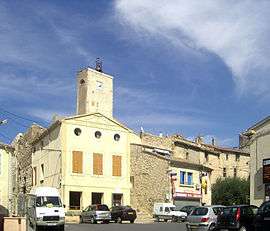 The Town Hall Square | |
 Coat of arms | |
Location of Argeliers 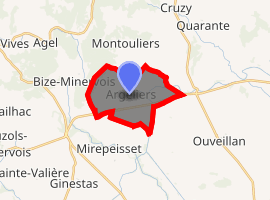
| |
 Argeliers 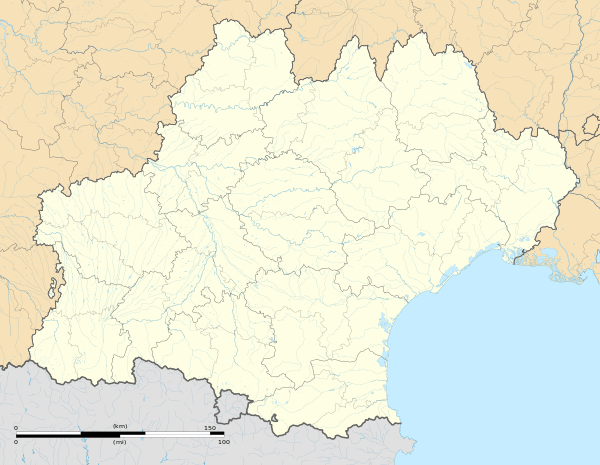 Argeliers | |
| Coordinates: 43°19′00″N 2°55′00″E | |
| Country | France |
| Region | Occitanie |
| Department | Aude |
| Arrondissement | Narbonne |
| Canton | Le Sud-Minervois |
| Intercommunality | Le Grand Narbonne |
| Government | |
| • Mayor (2014-2020) | Gilles Laur |
| Area 1 | 10.79 km2 (4.17 sq mi) |
| Population (2017-01-01)[1] | 2,139 |
| • Density | 200/km2 (510/sq mi) |
| Time zone | UTC+01:00 (CET) |
| • Summer (DST) | UTC+02:00 (CEST) |
| INSEE/Postal code | 11012 /11120 |
| Elevation | 26–220 m (85–722 ft) |
| 1 French Land Register data, which excludes lakes, ponds, glaciers > 1 km2 (0.386 sq mi or 247 acres) and river estuaries. | |
The inhabitants of the commune are known as Argeliésois or Argeliésoises[3]
Geography
Argeliers is part of the urban area of Narbonne located on the southern edge of the Haut-Minervois and in the north of the fertile sedimentary plain of Narbonne, 22 km west by south-west of Béziers and 16 km north-west of Narbonne at the foot of the first foothills north of the plain of Narbonne. The northern border of the commune is the border between Aude and Hérault departments. Access to the commune is by the D5 road from Capestang in the east passing through the commune south of the village and continuing to Pouzols-Minervois in the west. Access to the village is by the D326 from Mirepeisset in the south intersecting the D5 and continuing to the village then north-east. The D36E48 comes from Montouliers in the north changing to the D426 at the border and continuing to join the D5 south-west of the village. The D826 also connects the village to the D5. The village residential area covers about a quarter of the commune with forests along the western border and the rest of the commune is farmland.[4]
The Canal du Midi forms part of the eastern border of the commune passing through the commune east of the village where there are mooring facilities known as Port d'Argeliers. Other streams passing through the commune near the Canal include the Ruisseau des Gours and the Ruisseau de Roze.[4]
Neighbouring communes and villages[4]
History
The Argeliers committee
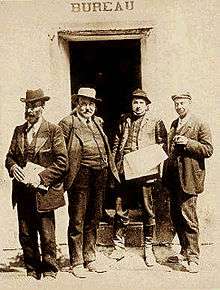
On 11 March 1907 a signal for revolt was given by a group of Minervois winemakers in the village of Argeliers. They were led by Marcelin Albert and Élie Bernard who founded the Committee for the Defence of Wine-making or the Argeliers Committee. He organized a march with 87 winemakers to Narbonne for an interview with a parliamentary commission. After his depositions the defence committee went around the town singing for the first time La Vigneronne which from that day became the anthem of the Beggars' revolt.[5]
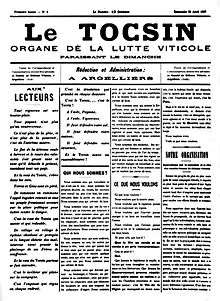
Élie Bernard was later appointed Secretary-General of the Confédération générale des vignerons du Midi (General Confederation of winemakers of Midi). It was the Argeliers committee, which included all the producers, who prepared a response to the crisis.[6] On 14 March Albert Sarraut from Bordeaux, Senator for Aude and Under Secretary of State for the Interior, was admonished by Clemenceau for trying to plead for his electorate: "I know the Midi, it will all end with a banquet" he said to Clemenceau who was then President of the Council which sat at Beauveau in the Ministry of Interior.[7]
On 24 March a first meeting organized by the Argeliers Committee was held at Sallèles-d'Aude in front of 300 people. Marcelin Albert was noted for his oratory and charisma. For the winemakers present he became the apostle, the king of beggars, or the Redeemer. The principle of holding a meeting every Sunday in a different town was adopted.[7]
On 21 April 10 to 15 thousand growers gathered at Capestang.[8] On that Sunday the first issue of Tocsin was published by the Argeliers Committee. This was a weekly paper directed by Marcelin Albert with Louis Blanc writing. This issue contained an address to Parliament to have a law voted against fraud.[7]
Heraldry
.svg.png) Arms of Argeliers |
Blazon: Azure, a pale fusilly Argent and Vert. |
Administration
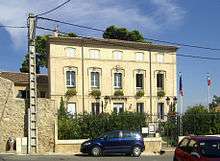
List of Successive Mayors[9]
| From | To | Name | Party | Position |
|---|---|---|---|---|
| 2001 | 2014 | Christian Rouzaud | PS | |
| 2014 | 2020 | Gilles Laur |
(Not all data is known)
Demography
In 2009 the commune had 1,683 inhabitants. The evolution of the number of inhabitants is known from the population censuses conducted in the commune since 1793. From the 21st century, a census of communes with fewer than 10,000 inhabitants is held every five years, unlike larger towns that have a sample survey every year.[Note 1]
| 1793 | 1800 | 1806 | 1821 | 1831 | 1836 | 1841 | 1846 | 1851 |
|---|---|---|---|---|---|---|---|---|
| 578 | 475 | 608 | 833 | 760 | 810 | 808 | 828 | 778 |
| 1856 | 1861 | 1866 | 1872 | 1876 | 1881 | 1886 | 1891 | 1896 |
|---|---|---|---|---|---|---|---|---|
| 810 | 851 | 922 | 1,019 | 1,205 | 1,590 | 1,258 | 1,410 | 1,422 |
| 1901 | 1906 | 1911 | 1921 | 1926 | 1931 | 1936 | 1946 | 1954 |
|---|---|---|---|---|---|---|---|---|
| 1,425 | 1,300 | 1,245 | 1,188 | 1,211 | 1,118 | 1,147 | 1,102 | 1,123 |
| 1962 | 1968 | 1975 | 1982 | 1990 | 1999 | 2006 | 2009 | - |
|---|---|---|---|---|---|---|---|---|
| 1,159 | 1,133 | 1,118 | 1,218 | 1,233 | 1,237 | 1,519 | 1,683 | - |
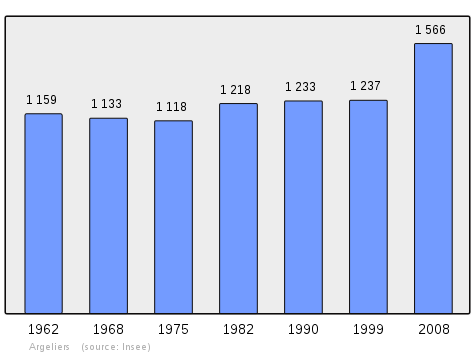
Economy
Viticulture: Minervois (AOC) and Languedoc (AOC)
Sites and Monuments
Notable people linked to the commune
- Marcelin Albert (1851-1921): leader of the winemakers of Midi revolt in 1907. He was born and died in the village and is buried in the cemetery there. A village square is named in his honour;
- Élie Bernard (?-1935): another leader of the winemakers revolt in Languedoc in 1907 with Richard and Cathala: at the start in Argeliers, imprisoned in Béziers prison with Dr. Ernest Ferroul, deputy mayor of Narbonne with Richard and Cathala, appointed director of the union newspaper Winemakers Action, then Secretary General of the General Confederation of winemakers, died in 1935;
- Étienne Bonnes (1894-?): International rugby player born in Argeliers;
- Leon Còrdas (1913-1987): writer, ran a theatre troupe in Argeliers.
- Max Roqueta a contemporary Occitan writer, was born in Argeliers in 1908.
See also
External links
- Ode to Aude Tourism website
- Winemakers Revolt in Argeliers 1907 (in French)
- Argeliers on Lion1906
- Argeliers on Géoportail, National Geographic Institute (IGN) website (in French)
- Argelliers on the 1750 Cassini Map
Notes and references
Notes
- At the beginning of the 21st century, the methods of identification have been modified by Law No. 2002-276 of 27 February 2002 Archived 6 March 2016 at the Wayback Machine, the so-called "law of local democracy" and in particular Title V "census operations" allows, after a transitional period running from 2004 to 2008, the annual publication of the legal population of the different French administrative districts. For communes with a population greater than 10,000 inhabitants, a sample survey is conducted annually, the entire territory of these communes is taken into account at the end of the period of five years. The first "legal population" after 1999 under this new law came into force on 1 January 2009 and was based on the census of 2006.
References
- "Populations légales 2017". INSEE. Retrieved 6 January 2020.
- Lionel Delvarre. "lion1906.com". lion1906.com. Retrieved 29 April 2010.
- Inhabitants of Aude (in French)
- Google Maps
- Amancio Tenaguillo y Cortázar, Wine in History. 1907: The Winemakers revolt in le Midi (in French)
- Winemakers Revolt 1907, Languedoc, 1911, Champagne (in French)
- Midi 1907, the history of the winemakers revolt (in French)
- The wine-growers crisis of 1907 on the histoireduroussillon.free.fr website (in French)
- List of Mayors of France (in French)
- Ministry of Culture, Mérimée PA00102537 Chateau of Argeliers (in French)

- Ministry of Culture, Palissy IM11000102 Monumental Fountain of Vendangeur (in French)
- Ministry of Culture, Palissy IM11000104 Monument to Raffit (in French)
- Ministry of Culture, Palissy IM11000103 Monument to Cabannes Didier (in French)
- Ministry of Culture, Palissy PM11001692 Painting: The Resurrection (in French)
- Ministry of Culture, Palissy PM11001691 Altar, Retable, and Painting: The Crucifixion (in French)
| Wikimedia Commons has media related to Argeliers. |